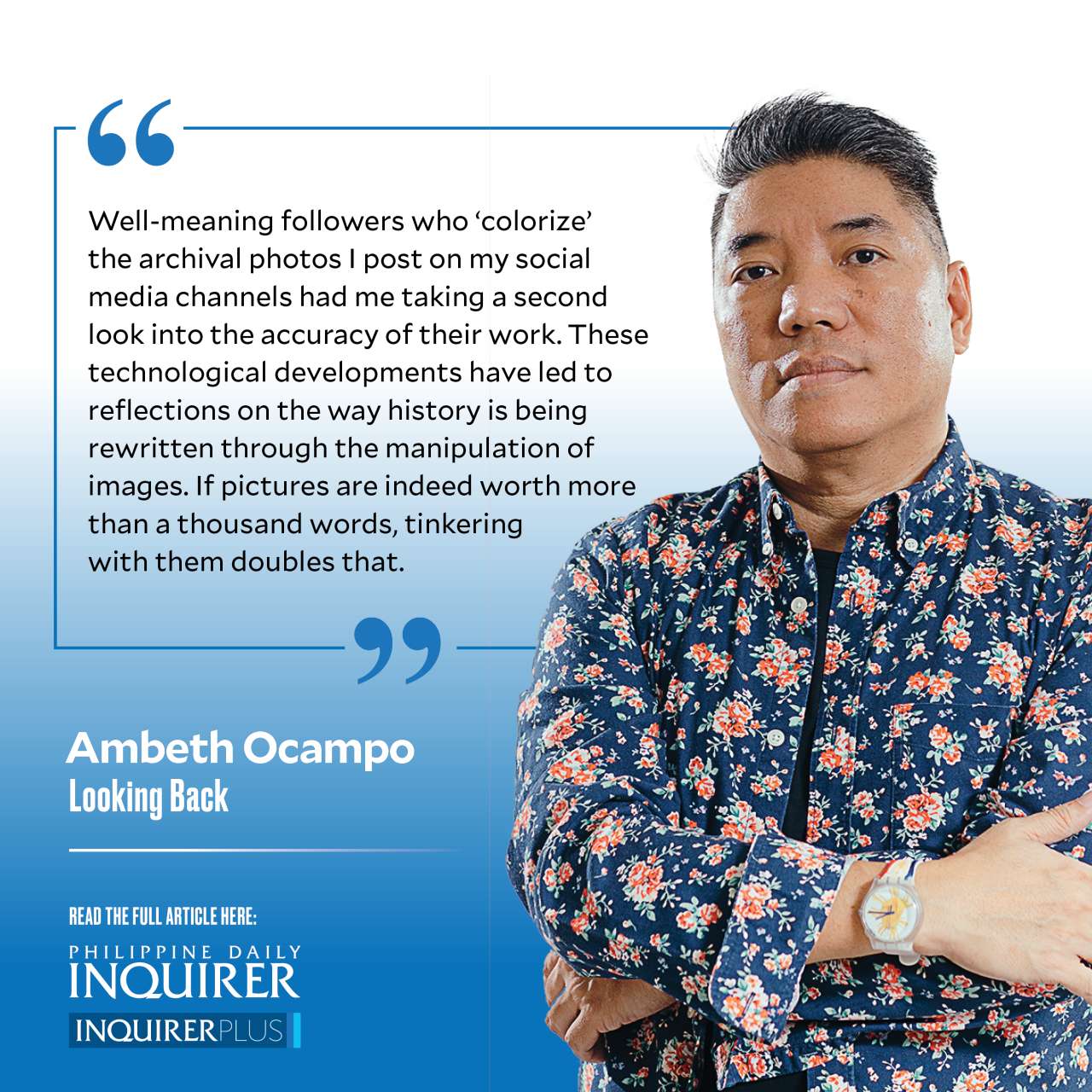Colorizing history

Apps are breathing new life into archival photographs by enhancing, correcting, and adding color to sepia or black and white. Some apps can even make the dead figures in archival photographs move and smile! Well-meaning followers who “colorize” the archival photos I post on my social media channels had me taking a second look into the accuracy of their work. These technological developments have led to reflections on the way history is being rewritten through the manipulation of images. If pictures are indeed worth more than a thousand words, tinkering with them doubles that.
Filing pictures of Jose Rizal and Juan Luna in my library entails more than labeling. I have to delete duplicates and keep the best image in the highest resolution. I try to date the images to file chronologically, determine the location of the photo, and identify everyone in group photos. Filing may entail a lot of work, but as the late Salvador H. Laurel used to say, “Patience is bitter, but its fruit is sweet.”
Juan Luna, like Rizal, was caught in many photographs that provide his likeness, but not the details like his complexion or distinguishing physical marks, which we can only know if we had seen him face to face. Photographs can give clues into his personality, but nothing beats full description in an archival document: a letter, a diary, a newspaper account. On Feb. 7, 1893, Juan Luna appeared before a French court trying him for the double murder of his wife, Paz Pardo de Tavera, and his mother in law, Juliana Gorricho, as well as the frustrated murder of his brother in law, Felix Pardo de Tavera, who survived a gunshot wound on his chest. I have not come across photographs or even sketches of the people in the courtroom, but we have a lot from contemporary reports.
The Gazette des Tribunaux described Luna as “small, very brown [with] the crushed face and the yellowish complexion characteristic of the races of the Far East. Very dejected, he answers questions in a low voice.” The Journal des Débats described him as “a man of small stature, of strongly marked Malay origin, morally one of simple and primitive nature that show, in turns, the gentleness of a child or woman, and the ferocity of a savage. His story is tragic and merits more than a banal mention.” From these racist descriptions, we see French people trying to figure out what this foreigner is all about, what makes him tick, what made him do the crimes he is accused of.
Unlike other Asians, Luna had a Hispanic name. He was, after all, from the Philippine islands, an overseas territory of Spain. A certain “Maitre Z” correspondent of the newspaper Le Gaulois described Luna as “small, [with] yellow-green complexion, [he] resembled a Japanese a lot more than a Spaniard. He was dressed in black. Certainly, he was no ordinary criminal. We feel in the presence of an individual from another race than ours, with a mysterious psychology, than our most skillful artists would have some difficulty to make clear. He is distant, exotic, transformed into an artist by education but, by instinct, reappears at times brutal and fierce. He replies to the questions of the president in chopped phrases, cut by sobs and the veritable cries of pain, and when the necessities of the interrogation bring up subject of his daughter who died, he finds in his foreign jargon expressions so sincere. His attitude leaves us to understand a distress that M. Pilet Desjardins who is presiding seems very moved.”
Albert Bataille, correspondent of Le Figaro, feigns surprise by stating: “Luna is not a Hidalgo! He is of Malay blood. With a broken nose, prominent cheekbones, copper complexion, eyes drawn in the Japanese style; he is thin, puny, and stunted, producing a singular, almost painful, impression. He expresses himself sufficiently in French.”
It is unfortunate that most of the popular accounts on Luna’s crime of passion are biased and largely based on postwar secondary sources, when a mountain of primary sources lie in wait to be scaled. I spent the pandemic lockdown doing a close rereading of all these sources and find them mostly sympathetic to the suspect. Only by primary source research can we bring life and color back to a man and a story frozen in photographs and documentation. My version of events coming soon.
—————-
Comments are welcome at aocampo@ateneo.edu




















